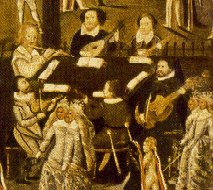ENGLISH CONSORT MUSIC

Starting in the 1580s in Elizabethan England, theatergoers would have been treated to performances by a unique combination of six instruments that we now call a Broken Consort or Mixed Consort. Those terms were not used at that time — the English referred to this specific group of instruments simply as a “consort,” described in a letter of 1575 as “compoounded of six severall instruments.” It may be confusing to modern readers that “consort” nowadays means almost any combination of instruments — like or unlike — playing as an ensemble.
In a gallery above and over the stage, behind a curtain, musicians would perform during plays and between acts. “Heavenly” or “celestial” were often mentioned in reference to this consort because of the beauty and delicacy of the blend of instruments and because the music wafted down from unseen musicians above. Perhaps first brought together for theatrical effect (viols or violins were used to suggest harmony, flutes to suggest death or repose, plucked strings for lively dances), this heavenly group was composed of treble viola da gamba or violin, flute or recorder, lute, cittern, bandora and bass viola da gamba. Treble and bass violas da gamba, or viols, are stringed instruments resembling a violin and a cello. A cittern is a small plucked or strummed instrument that has courses, or sets, of wire strings, making a sound much like that of a modern banjo. A bandora is a larger stringed instrument also with courses of metal strings.

The instruments of the mixed consort
from Praetorius, Theatrum Musicum, 1620
The Morley Consort Lessons survive in 2 printings, one of 1599 and one of 1611. Between the two editions, all the partbooks survive except for the lute. All of the other sources — Walsingham, Rosseter and Cambridge — are also missing partbooks. Therefore any performing edition of these works requires reconstruction of the missing instrumental lines. Performing reconstructions are usually prepared by combining the surviving consort books with versions of the pieces from other sources.
There are a couple of recordings of this repertoire that are truly excellent. The first is by the Dowland Consort and is aptly titled “Heavenly Noyse.” On this recording, 14 pieces for broken consort are presented – 10 from Morley and 4 from Rosseter. There are also 9 other pieces for various instruments on the recording. The performances are wonderful with amazing lute playing that helps you understand why all noblemen in the Renaissance aspired to play the lute. The recording is on BIS, CD-451.
The second recording of note is by the Musicians of Swanne Alley and is entitled “As I Went to Walsingham.” It contains music from the Walsingham consort books as well as other sources. This disc is dedicated to Sir Francis Walsingham, who was a great patron of the arts. The Walsingham Consort books are manuscripts copied for use in his household and some pieces in it are named for Sir Francis and his wife. This album contains songs as well as instrumental music. The recording is on Harmonia Mundi USA, CD 905192.